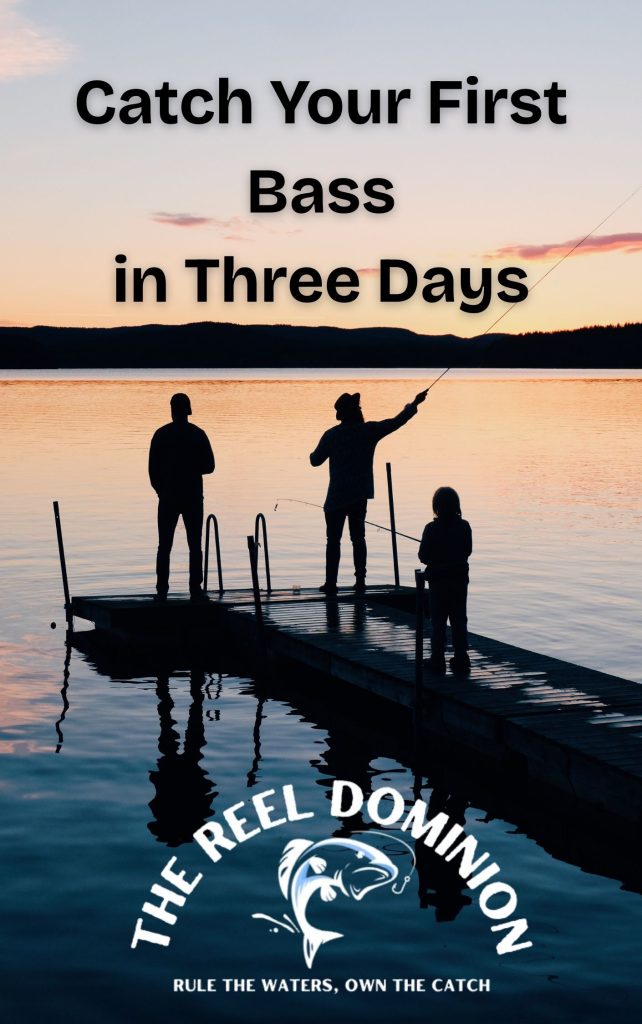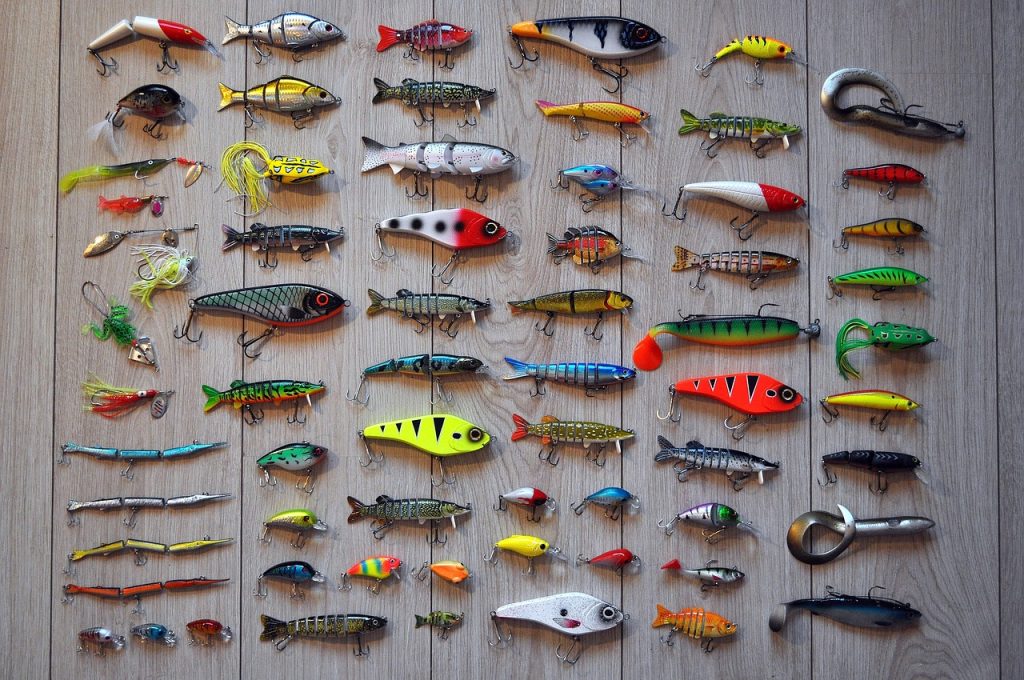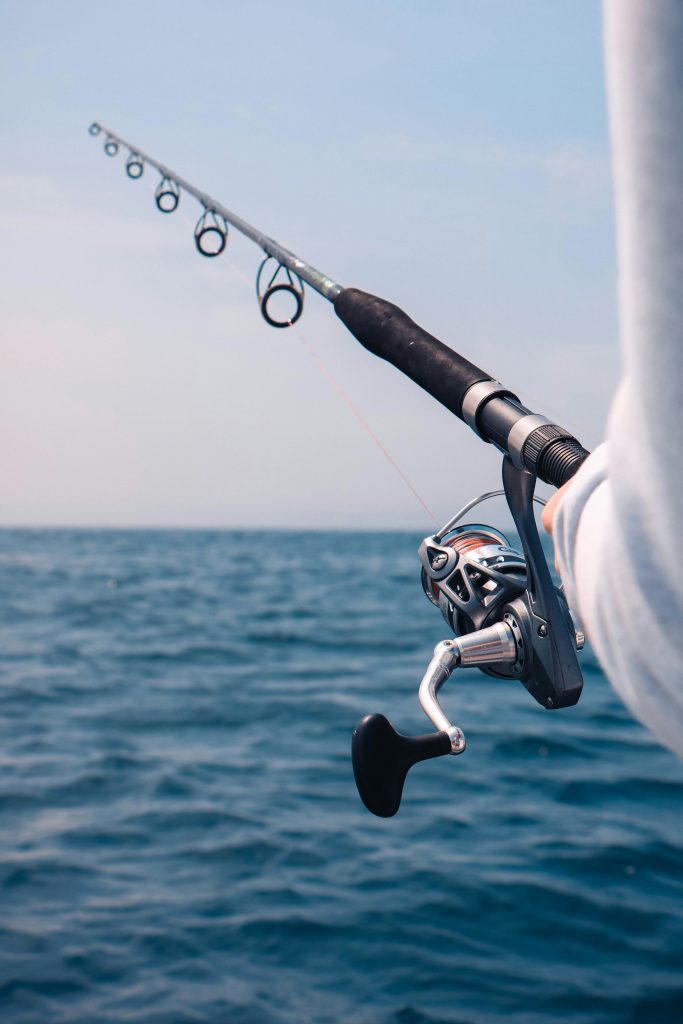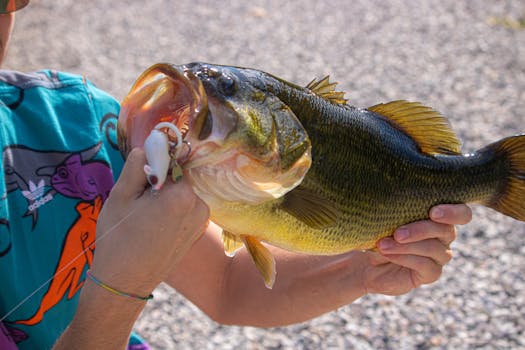Disclosure: This post contains affiliate links. If you buy something through these links, I may earn a small commission at no extra cost to you. Learn more here.
Table of Contents
Fishing lures are more than just colorful pieces of tackle—they’re precision tools designed to mimic prey and trigger predatory instincts in fish. Understanding the science behind lure design and selection of the different types of fishing lures can significantly enhance an angler’s success.
Research has shown that lure characteristics such as color and size can influence catch outcomes. For instance, a study published in Fisheries Research found that while lure color didn’t significantly affect catch rates, bright-colored lures tended to attract larger largemouth bass compared to dark or natural-colored lures.
Similarly, the size of the hook and bait plays a crucial role in the size of fish caught. A study in the Marine and Coastal Fisheries journal demonstrated that using larger hooks and baits increased the catch efficiency for larger species like the Spangled Emperor and Orange-spotted Grouper. Specifically, the catch efficiency for 40 cm Spangled Emperor increased by 150% when using a larger hook size.
Moreover, the type of lure used can target specific behaviors and habitats of fish. For example, jigs are effective for bottom-dwelling species due to their vertical motion, while spinnerbaits, with their vibrating and flashing blades, are designed to provoke strikes from predatory fish by mimicking the movement of small prey.
In this article, we’ll explore the ten most popular types of fishing lures, delving into the science behind their design and effectiveness, and providing guidance on when and how to use each one to maximize your fishing success.

Ready to catch more bass? This comprehensive eBook breaks down everything you need to know about choosing the right lure, understanding bass behavior, and matching technique to conditions. Whether you’re a beginner or a seasoned angler, you’ll find practical, research-backed insights and product links to gear that works.
What Are the Different Types of Fishing Lures?
Fishing lures come in a wide variety of shapes, sizes, and materials—each designed to mimic the movement, appearance, or sound of prey fish. The main types of fishing lures include crankbaits, spinnerbaits, jigs, soft plastics, topwater lures, spoons, and jerkbaits. Each type serves a unique purpose and works best under specific conditions or for targeting certain fish species.
- Crankbaits dive and wobble through the water to imitate baitfish, making them ideal for covering large areas quickly.
- Spinnerbaits create flash and vibration, attracting bass and other predators in murky or stained water.
- Jigs are versatile and effective for bottom-feeding species, especially when tipped with soft plastic trailers.
- Soft plastics like worms, craws, and swimbaits are incredibly lifelike and can be rigged in multiple ways.
- Topwater lures such as poppers and frogs are great for exciting surface strikes, especially during low-light hours.
- Spoons flash and flutter to imitate injured baitfish, making them effective for both freshwater and saltwater fishing.
- Jerkbaits dart and pause, triggering reaction strikes from aggressive or curious fish.
Choosing the right type of lure depends on the fish you’re targeting, the water clarity, depth, and time of year. By understanding the different types of fishing lures, you can improve your chances of landing more fish and make smarter choices on the water.
1. Spinnerbait
What it is:
Spinnerbaits are versatile lures characterized by one or more metal blades that spin like a propeller when the lure is in motion. These blades reflect light and create vibrations, mimicking the movements of small fish or other prey. The lure’s body often includes a skirt made of silicone or rubber strands, adding to its lifelike appearance.
When and where to use it:
Spinnerbaits excel in various fishing conditions, particularly in murky or stained waters where visibility is low. The combination of flash and vibration makes them highly effective in attracting fish that rely on senses other than sight. They’re also ideal for fishing around structures like submerged timber, weed beds, and rocky outcrops. The design of spinnerbaits allows them to navigate through vegetation and obstacles with minimal snagging.
Species it targets:
Spinnerbaits are known for their ability to attract a wide range of predatory fish species. They’re particularly effective for:
- Largemouth Bass: The vibration and flash appeal to their aggressive nature.
- Northern Pike: The lure’s movement mimics prey, enticing strikes.
- Walleye: Especially effective in low-light conditions.
- Perch: Smaller spinnerbaits can be used to target these fish.
Scientific insights:
Research has shown that the effectiveness of spinnerbaits can be attributed to their ability to stimulate the lateral line system of fish, which detects vibrations and movement in the water. A study on fish sensory systems highlights the importance of such stimuli in predatory behavior.
Tips for use:
- Retrieve speed: Varying the speed can influence the lure’s depth and action.
- Blade type: Willow blades produce more flash, while Colorado blades create more vibration.
- Color selection: Bright colors for murky water; natural colors for clear water.
2. Crankbait
What it is:
Crankbaits are hard-bodied lures designed to mimic the swimming action of baitfish. They typically feature a plastic or metal lip (bill) that causes the lure to dive and wobble when retrieved. The size and angle of the lip determine the depth and action of the lure.
When and where to use it:
Crankbaits are versatile and can be used in various water conditions. They’re particularly effective when targeting fish around structures like submerged logs, rocks, and weed beds. The erratic movement and noise produced by crankbaits can provoke reaction strikes from predatory fish.
Species it targets:
Crankbaits are effective for species such as:
- Bass: Both largemouth and smallmouth bass are attracted to the wobbling action.
- Walleye: Especially responsive to crankbaits in deeper waters.
- Pike: The flash and vibration can entice aggressive strikes.
Scientific insights:
The effectiveness of crankbaits can be attributed to their ability to stimulate the lateral line system of fish, which detects vibrations and movement in the water.
Tips for use:
- Retrieve speed: Varying the speed can influence the lure’s depth and action.
- Color selection: Use bright colors in murky water and natural colors in clear water.
- Depth control: Choose crankbaits with appropriate lip sizes to target specific depths.
3. Jig
What it is:
A jig is a versatile fishing lure consisting of a weighted head (often made of lead) molded onto a hook, typically adorned with a soft body or skirt made from materials like rubber, silicone, or feathers. This design allows the jig to sink quickly and be manipulated to mimic the erratic movements of injured prey.
When and where to use it:
Jigs are particularly effective in freshwater environments, especially when targeting fish near the bottom. They’re ideal for fishing around structures such as submerged timber, rocks, and weed beds. The vertical “jigging” motion—lifting and dropping the lure—can entice fish that are holding close to the bottom or in cover.
Species it targets:
Jigs are known for their versatility and can attract a variety of species, including:
- Largemouth and Smallmouth Bass: Effective when fished around structures and in deeper waters.
- Walleye: Particularly responsive to jigs presented near the bottom.
- Panfish: Smaller jigs can be used to target species like crappie and bluegill.
Scientific insights:
The success of jigs can be attributed to their ability to stimulate the lateral line system of fish—a sensory organ that detects vibrations and movement in the water. The vertical motion and subtle vibrations produced by jigs can trigger predatory responses, especially in low-visibility conditions.
Tips for use:
- Presentation: Use a hopping or dragging motion along the bottom to imitate prey.
- Color selection: Match the jig’s color to the local forage and water clarity—natural colors in clear water and brighter hues in murky conditions.
- Trailer addition: Enhance the jig’s appeal by adding a soft plastic trailer, such as a crawfish or grub imitation.
4. Swimbait
What it is:
Swimbaits are lures designed to replicate the appearance and swimming action of baitfish. They come in various forms:
- Hard-body swimbaits: Often segmented to create a lifelike swimming motion.
- Soft-body swimbaits: Made from soft plastic, offering a more natural feel when bitten.
- Paddle tail swimbaits: Feature a tail that creates a kicking action during retrieval.
Originally developed in the late 1980s to imitate rainbow trout in Southern California reservoirs, swimbaits have evolved to target various predatory fish.
When and where to use it:
Swimbaits are most effective in clear water conditions where fish rely heavily on sight to hunt. They’re ideal for targeting larger predatory fish around structures like submerged vegetation, rocks, and drop-offs. The realistic appearance and movement can entice wary fish that might ignore other lure types.
Species it targets:
Swimbaits are particularly effective for:
- Largemouth Bass: Especially larger specimens that feed on sizable prey.
- Northern Pike and Musky: The lifelike action can provoke aggressive strikes.
- Striped Bass: Effective in both freshwater and saltwater environments.
Scientific insights:
The effectiveness of swimbaits lies in their ability to mimic the natural swimming motion of prey, triggering predatory instincts. The visual realism, combined with the movement, can override a fish’s caution, leading to strikes even from pressured or educated fish.
Tips for use:
- Retrieve technique: Use a steady retrieve to mimic a swimming baitfish, or add pauses to imitate a wounded fish.
- Size selection: Match the swimbait’s size to the local forage and target species.
- Rigging: Ensure proper hook placement to maximize hook-up ratios, especially with larger swimbaits.
5. Spoon
What it is:
Spoons are metal lures with a concave, oblong shape, designed to reflect light and wobble as they move through the water. This action mimics the appearance of an injured baitfish, making them attractive to predatory fish.
When and where to use it:
Spoons are versatile and can be used in various fishing situations, including casting, trolling, and jigging. They’re effective in both freshwater and saltwater environments, particularly in areas with open water or near structures. The flash and vibration produced by spoons can attract fish from a distance, making them ideal for covering large areas.
Species it targets:
Spoons can attract a wide range of species, such as:
- Trout and Salmon: Effective in both rivers and lakes.
- Pike and Musky: The flash and wobble can entice aggressive strikes.
- Bass: Particularly effective when fish are feeding on baitfish.
Scientific insights:
The erratic movement and light reflection of spoons can stimulate the lateral line system of fish, prompting them to strike. The combination of visual and vibrational cues makes spoons effective even in low-visibility conditions.
Tips for use:
- Retrieve speed: Vary the speed to change the action and depth.
- Color selection: Use silver or gold in clear water and brighter colors in murky conditions.
- Depth control: Allow the spoon to sink to the desired depth before retrieving.
6. Topwater Lure
What it is:
Topwater lures are designed to float on the surface and create commotion that mimics struggling or fleeing prey—often frogs, mice, insects, or injured baitfish. Common types include:
- Poppers (make splashing sounds)
- Walking baits (e.g., Zara Spook – “walk-the-dog” motion)
- Prop baits (with rotating blades)
- Hollow-body frogs (weedless, ideal for vegetation)
These lures are highly visual and audible, making them ideal for sight-feeding predatory fish.
When and where to use it:
Topwater lures shine in:
- Low-light conditions (early morning, late evening, or overcast days)
- Shallow water with vegetation, lily pads, timber, or docks
- Summer and early fall, when fish hunt near the surface
- Calm water, where ripples and splashes stand out
They’re excellent for drawing explosive surface strikes and covering large areas quickly to locate fish.
Species it targets:
- Largemouth & Smallmouth Bass
- Pike
- Muskie
- Striped Bass in salt or brackish conditions
Scientific insights:
Topwater lures exploit the surface tension barrier where fish rely more on vision and lateral line sensitivity. According to Lychakov & Rebane (2005), fish use both acoustic and surface vibration cues to locate prey—especially when prey is at the water-air interface. Visual strikes are often triggered by silhouette contrast and erratic motion, particularly in ambush predators like bass and pike.
Tips for use:
- Use the “walk-the-dog” technique for baits like the Heddon Zara Spook, keeping the lure zigzagging on the surface.
- Pause after splashdown—some fish hit on the pause.
- Color matters: Use dark colors in low light for contrast; natural hues for clear water.
- Avoid overworking the bait—too much motion can look unnatural.
Example lure:
Heddon Zara Spook – iconic for its “walk-the-dog” action and a favorite among bass anglers for decades.
7. Soft Plastic Lure
What it is:
Soft plastic lures are flexible, rubbery baits molded to resemble worms, minnows, crawfish, frogs, grubs, and more. Their lifelike feel and movement make them incredibly versatile and effective. They can be rigged in countless ways:
- Texas rig (weedless)
- Carolina rig (for deeper water)
- Wacky rig (center-hooked)
- Ned rig, drop shot, and swimbait styles
Many soft plastics also feature scent and salt infusion to encourage fish to hold on longer.
When and where to use it:
Soft plastics are true all-season, all-condition lures. Use them:
- Year-round, especially during cold fronts when fish are sluggish.
- In thick cover or clear water, depending on the rig.
- On bottom structure, weed lines, or rock piles.
- When fish are wary or pressured—soft plastics can finesse bites that other lures won’t.
Species it targets:
- Largemouth & Smallmouth Bass
- Walleye
- Trout
- Panfish (bluegill, crappie)
- Redfish and flounder in saltwater settings
Scientific insights:
Soft plastics are particularly effective due to their tactile realism. A study by Gardiner & Motta (2012) found that fish are more likely to hold onto lures that mimic the texture and flexibility of prey. This increases the angler’s hookset window dramatically. Additionally, slow presentations (e.g., drop shot) align with fish’s energy conservation strategies, especially in colder water.
Tips for use:
- Match your rig to the structure and season.
- Use natural colors in clear water and bright colors in murky water.
- Add scent attractant to boost retention.
- Downsize in pressured waters—finesse worms and grubs can save the day.
Example lure:
Gary Yamamoto Senko – an industry standard for wacky or Texas rigs with irresistible slow-fall action.
8. Buzzbait
What it is:
Buzzbaits are topwater wire lures designed to churn across the water’s surface, creating noise, vibration, and splashes that attract fish from below. The head and skirt resemble spinnerbaits, but instead of spinning blades beneath the surface, a single or double-blade propeller spins on the arm above the bait, creating surface commotion.
This lure doesn’t dive—it’s meant to ride the surface during a fast retrieve, imitating distressed prey.
When and where to use it:
Buzzbaits excel in shallow, weedy, or grassy areas, especially where fish are lurking just below the surface to ambush prey. They’re best used:
- Early morning or late evening when fish are most active.
- During warmer months, especially late spring through early fall.
- Over calm or slightly choppy water for maximum effect.
Use them to cover water quickly and draw reaction strikes from aggressive fish.
Species it targets:
- Largemouth Bass: Highly reactive to the surface disruption.
- Pike: Known to explode on buzzbaits retrieved over weed beds.
- Peacock Bass and Snakehead (in tropical climates): Equally responsive to the commotion.
Scientific insights:
Buzzbaits trigger a predatory response by imitating the acoustic footprint of a struggling surface prey. Research on acoustic attraction in fish shows that surface vibrations resembling prey distress sounds increase predatory strike probability, particularly in ambush predators (Radford et al., 2012). Additionally, the silhouette and splash mimic a wounded or panicked creature—perfect for drawing instinctual strikes.
Tips for use:
- Immediate retrieve: Start reeling as soon as the lure hits the water to keep it on the surface.
- Add a trailer hook to improve hook-up ratio, as fish often swipe short at buzzbaits.
- Choose color by light level: Black or dark for low light, white or chartreuse for bright conditions.
- Speed control: Adjust retrieve speed based on fish aggression—slower for tentative fish, faster for explosive chasers.
9. Topwater Lure
What it is:
Topwater lures are a category of floating lures that remain on or near the water’s surface. They include poppers, walk-the-dog lures (like Zara Spooks), prop baits, and hollow-body frogs. These lures rely on sound, splash, and erratic surface motion to imitate struggling prey like frogs, baitfish, or insects.
They often feature concave faces (poppers), side-to-side action (walkers), or rotating props (prop baits), and are retrieved with specific cadences to mimic lifelike movement.
When and where to use it:
Topwater lures are best when fish are feeding near the surface or in shallow cover:
- Early morning or dusk, when light is low and fish are cruising the shallows.
- Around lily pads, grass mats, docks, or timber, where surface strikes are likely.
- During post-spawn or pre-fall feed-up, when predators hunt aggressively.
Species it targets:
- Bass (Largemouth & Smallmouth): Huge topwater fans, especially around cover.
- Pike and Muskie: Explosive topwater attackers.
- Striped Bass & Redfish: In brackish or saltwater flats, often pursue topwater plugs.
Scientific insights:
Topwater success ties closely to predator-prey interaction under sensory constraints. According to New et al. (2001), visual and auditory cues—especially those mimicking erratic or distressed movements at the surface—trigger “surprise response” attacks in fish. The surface creates an acoustic mirror, amplifying the bait’s movement to fish below, which enhances strike potential.
Tips for use:
- “Walk the dog” technique: Use rhythmic rod twitches for side-to-side action with walking lures.
- Let it sit: Sometimes a 2–3 second pause after splashdown increases hits.
- Color contrast: Use dark lures in low light for silhouette visibility; natural colors for clear, calm conditions.
- Match to hatch: Pick shapes and movements similar to frogs, mice, or baitfish common in the local ecosystem.
10. Mepps Fishing Lure
What it is:
Mepps lures are a legendary line of spinners renowned for their simplicity and effectiveness. Their distinctive design includes a spinning blade and a weighted body that generates vibrations and reflections, simulating the movement of baitfish. The most popular styles are:
- Aglia (classic, with a plain or dressed hook)
- Comet (features a body with more flash)
- Black Fury (designed for murkier waters with a darker color)
The spinning blade creates a flash of light, which attracts fish through sight and vibration, making them particularly effective in low-visibility conditions or deep water.
When and where to use it:
Mepps spinners are highly versatile, but they truly shine when:
- Fishing in murky waters, where the flash and vibrations help fish locate the lure.
- Targeting species that are actively chasing prey, such as bass, pike, trout, or salmon.
- Moving through current, such as in rivers or streams where the spinner can be retrieved at various speeds to simulate injured prey.
- Casting over deep water, where the vibrations of the blade travel longer distances to draw attention.
They are a go-to option for both fast-moving rivers and calmer, deeper lakes.
Species it targets:
- Trout (Rainbow, Brown, Brook)
- Bass (Largemouth, Smallmouth)
- Northern Pike and Muskie
- Salmon and Steelhead
Scientific insights:
The flash and vibration created by Mepps lures are especially effective for attracting fish that rely on the lateral line system. According to research by Barlow (2004), fish use their lateral line to detect pressure waves and movement in the water, which allows them to track prey even in low visibility. The reflected light from Mepps’ shiny blades simulates the glimmer of a fish’s scales, increasing the likelihood of attracting predatory species.
Tips for use:
- Vary your retrieve speed to mimic different types of prey. A slow, steady retrieve imitates a wounded fish, while a faster retrieve can simulate a fleeing baitfish.
- Use contrasting colors in clear water for better visibility and brighter colors in murkier water to increase contrast.
- Target fish holding near structure like submerged rocks, vegetation, and drop-offs.
- Experiment with the depth—Mepps spinners are designed to work effectively both at the surface and deeper in the water column depending on retrieval speed.
Example lure:
Mepps Aglia Spinner – One of the most popular and effective choices in the Mepps line, ideal for a variety of fish species and conditions.

Ready to catch more bass? This comprehensive eBook breaks down everything you need to know about choosing the right lure, understanding bass behavior, and matching technique to conditions. Whether you’re a beginner or a seasoned angler, you’ll find practical, research-backed insights and product links to gear that works.
Bonus: Seasonal Considerations or Beginner Tips
Seasonal Considerations:
When using lures like topwater, soft plastics, or spinners, it’s important to consider the seasonal patterns of fish, as their behavior and feeding habits change throughout the year.
- Spring: As water temperatures rise, fish like bass and pike become more active and begin moving toward shallow water to spawn. This is a great time to use soft plastics and topwater lures to mimic the abundant prey in these areas. Some lures shine in spring—see our guide for spring-specific tips.
- Summer: During the hot months, fish often seek cooler, deeper water. For this reason, soft plastics rigged on a Carolina rig or drop shot can be incredibly effective. Topwater lures, on the other hand, work best during low-light conditions (early morning or late evening) when fish are more likely to be feeding near the surface.
- Fall: Fish are in a feeding frenzy as they prepare for winter, and topwater lures can draw exciting strikes. Spoons and swimbaits work well during this time to cover different water depths and find where fish are feeding.
- Winter: Cold water temperatures slow fish metabolism, making them less aggressive. Soft plastics fished slowly, often in deeper waters, can help attract bites. Jigging spoons are excellent for winter fishing, especially in lakes or rivers with suspended fish.
Using the right rod makes a huge difference—here’s our full buyer’s guide.
Beginner Tips:
- Start simple: As a beginner, it’s best to start with a few versatile lures that work in various conditions. Soft plastics (e.g., worms, creature baits) and spinners are perfect for new anglers due to their ease of use.
- Learn the retrieval techniques: Mastering the right retrieval speed and technique is crucial. For example, topwater lures work best with a steady, rhythmic retrieve, while soft plastics should be retrieved slowly for a more natural presentation.
- Focus on structure: Fish are more likely to be near structures like submerged rocks, vegetation, or drop-offs. Targeting these areas can increase your chances of success.
Ready to take it further? Check out our ultimate guide to bass fishing lures for advanced tactics.
FAQ Section
Q: What is a frog fishing lure used for?
A: Frog fishing lures are designed to mimic the movement of frogs, which are a natural food source for many predatory fish, especially bass. These lures are most effective in weedy or grassy areas where frogs are abundant. They create surface disturbances, attracting fish from a distance, and are great for fishing in low-light conditions or during the warmer months when fish are actively feeding on surface prey.
Q: What’s the difference between spoons and spinners?
A: Both spoons and spinners are effective for attracting fish, but they work in different ways. Spoons are metal lures with a curved body that creates a wobbling, erratic action when retrieved. They’re especially effective in deeper waters and are ideal for trout, pike, and walleye. In contrast, spinners feature a rotating blade that flashes light and creates vibrations. The flash of a spinner mimics the appearance of injured fish, making them effective in murky waters or when fish are feeding actively on the surface. Spinners tend to work best in faster-moving water, while spoons are great for deeper, slower areas.
If you’re brand new to bass fishing, start here. Try our bass fishing for beginners guide.




Good shout.